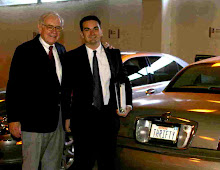A look at ebay - Part 2
What do I mean by remarkable rates of growth? Well, in 2005, 2004 and 2003, net income grew by 39%, 77% and 76% respectively. Revenue growth was comparable, at 39%, 51% and 78%. These numbers are phenomenal. All the while, profit margins have remained strong. Since 2000, the company seems to have focused on this. It made an important, and very wise, acquisition when it bought Paypal in 2002. In contrast to other acquisitions the company has made (to be discussed momentarily), Paypal not only yielded natural synergies with the flagship website, but was also a great, profitable company in its own right. Net margins got a nice boost from this acquisition, jumping from around 10% in 2001 to the current level of around 23%.
Despite the amazing growth in sales and income, ROE and ROIC have not budged, staying around 12% since 2000. Ebay has never paid a dividend, and rarely has assumed debt, so much of this invariability is due to the company’s retained earnings balance which has mushroomed along with earnings. But another big part of this phenomenon is the company’s continued issuance of new equity, whether it be the result of option exercise or SEOs. Indeed, the company’s paid in capital account has risen faster than retained earnings in every one of the last five years. So although the company is indeed growing by just about every measure, it has never become more productive. But 12% is not awful either, so as long as earnings keep going up, I suppose this is a pretty good indicator.
In general I would say that Ebay’s fundamentals seem consistent with the franchise value and competitive analysis I wrote about in Part 1. But one huge exception to the strength of Ebay’s franchise results from the acquisition the company made in 2005 of Skype Technologies, S.A. Skype is a voice-over-internet protocol provider, similar to its chief competitor, Vonage. After first hearing about this acquisition, I had a suspicion that it was a bad move.
As I have shown, Ebay has enormous brand value. But Skype operates in an industry where brand value does not go nearly as far. While the company is indeed a leader, I see no compelling reason to believe it must continue to be. The industry has very low barriers to entry, its technology is fast-changing and could potentially be supplanted by a superior technology in the future. More importantly, though, it provides a commodity-like service. Purchasers of VoIP, especially as the industry matures and new entrants enter the market, base their purchase decision in large part on price. This is a recipe for low returns, and something the individual investor should simply avoid were it a stand-alone company.
I find it telling that throughout Ebay’s 2005 annual report, management makes reference to all of the great operational ways Skype will help Ebay’s traditional operations, although management avoids ever using the word “synergies,” but fails to ever brag about what Skype will contribute to the company’s bottom line, profit margins or ROE. So let us take a closer look at what happened last fall.
Skype was purchased in October 2005 for about $2.6 billion (that is not a typo – that is billion with a “b.”) of which an amazing $2.3 billion was booked as goodwill. The remaining $300 million accounted for Skype’s tangible assets. Does a price-to-book ratio of 8.6 sound high to you? It did to me, so I did a little more investigation to put this number in to context.
For starters, the $2.6 billion is an understatement of the true cost, as Ebay also assumed obligations to pay nearly $1.3 billion in incentives to Skype executives should they meet certain targets. That is a lot of money, since at the time of the acquisition, Skype had never turned a profit. It is estimated, though, that Skype brought in $60 million in revenue 2005. (After the acquisition, of course, Skype’s revenues were consolidated with Ebay’s so it is difficult to tell exactly how much the company sold. But it wasn’t much.) That $60 million in earnings puts the purchase price at a beefy price-to-sales multiple of 65.
More importantly, though $2.6 or $3.9 billion is simply a lot of money for Ebay, which had balance sheet totals at the end of FY2004 of only $8 billion. So in essence, Ebay, the company with the dreamy business model and an iron-clad-alligator-infested moat, is wagering nearly half of its net worth on the future of Skype, which I believe to be very uncertain. This is downright foolishness in my opinion.
As always, any and all comments are welcome.

